Bushfires account for 40% of fatalities associated with declared disasters in Australia. A significant proportion of these fatalities occur closer to forested areas because over 90% of the recorded locations for the deaths were within 100 metres of bushland areas. Despite this, there has been an increase in people relocating to now-considered high-risk bushfire areas. This paper considers why people live in bushfire-prone areas particularly following Australia’s 2019–20 catastrophic summer bushfires. The study used a qualitative approach and conducted 30 semi-structured interviews with people living in the southeast part of New South Wales; a region hardest hit during the 2019–20 summer bushfire season. The interviews identified 7 reasons, as given by the participants, concerning why they thought people continued to move near bushland. The reasons were a quest for a ‘tree change’, proximity to family, location beauty, place attachment, work-related needs, property affordability and partner-related factors. These reasons were categorised into internal and external factors. This study serves as a useful reference when creating ways to encourage early self-evacuation and, ultimately, to reduce injuries and fatalities. These findings are not exhaustive and do not represent the entirety of New South Wales nor Australia or other countries. However, they represent a sample of lived experience by participants. Future studies might cover wider areas and include great numbers of participants and so garner diverse opinions about locations where people live and the hazard experienced.
Introduction
Bushfire is an annually reoccurring hazard that causes significant damage to property and life, arable land, ecosystems and infrastructure worldwide (Goswami et al. 2018; Labossière and McGee 2017). In Australia, millions of hectares of land are burnt; homes and properties are destroyed; infrastructure is damaged and wildlife suffer death, injury and habitat destruction (Booth 2020). High numbers of deaths are recorded due to bushfires in relation to other disasters (Venn and Quiggin 2015). The 2019–20 bushfire season in Australia led to 35 fatalities, the economic costs of mental health issues amounted to $1.95 billion (Kohlbacher 2020) and insurance losses amounted to $1.7 billion (Wittwer and Waschik 2021).
Australia is among the most bushfire-prone places in the world (NSW Rural Fire Service 2019). Successive bushfires have affected the communities living within or near fire-prone forests and rangelands in terms of loss of lives, homes and infrastructure destroyed (Labossière and McGee 2017). In bushfires, people are susceptible to smoke inhalation and, over 2019 and 2020, there were 429 smoke-related deaths in addition to the 35 people directly killed by bushfires (Kohlbacher 2020). According to Venn and Quiggin (2015), 40% of deaths associated with bushfires in Australia occurred due to the increased per capita fatality rate and mental health consequences. People are at risk of bushfire because they tend to live in urban-bush interfaces (Kruize et al. 2019). In addition, people move to urban bushland regions because it offers affordable housing and less population congestion (Anton and Lawrence 2016). However, the risk is increasing as research indicates increased occurrences of bushfire is due to the rise in extreme temperature, increasing wind speed, low humidity and decreased rainfall (Booth 2020, Neale 2016, van Oldenborgh et al. 2021). The changes in climate implies an increased likelihood of bushfire severity, fatalities and damage to infrastructure along with health-related issues (McLennan et al. 2018). However, despite these risks, it appears people may not realise or may not pay adequate attention to the risks inherent in bushfire-prone areas. These people usually underestimate the risks of living in these regions and may also be inadequately prepared for a bushfire event (Koksal, McLennan and Bearman 2020). The aim of this study was to investigate why people elect to live in bushfire-prone locations.
Materials and methods
An inductive research approach was used that involved collecting qualitative data through semi-structured interviews. While the research aimed to identify why people live in bushfire-prone areas despite the prediction of more frequent and more severe bushfires, the interview method was chosen because it allows researchers to gain insights into participant views.
Participants were recruited from southeast New South Wales, which was severely affected by bushfires between December 2019 and January 2020. The recruitment process involved sending flyers about the research through local council newsletters, community Facebook groups and notice boards. Potential participants responded and were selected purposively from 3 local councils of Bega Valley Shire (population=33,253), Eurobodalla Shire (population=37,232) and Goulburn Mulwaree (population=29,609)1 councils as they indicated an interest and willingness to participate in the study. Figure 1 shows the council areas within New South Wales that were selected for the study. A total of 30 respondents participated in the study.
Participants were referred to using alphanumeric codes rather than their names to provide confidentiality. The interviews were conducted using a structured interview guide and were conducted face-to-face, online via Zoom and by phone. Interviews lasted between 40 and 90 minutes. They were recorded, transcribed using Otter.AI and analysed using thematic content analysis via NVivo 12 Pro©. This method involved identifying, analysing and reporting patterns or themes within the data. The data were used to examine perspectives of how people’s decisions were formed using a decision-making framework (Adedokun et al. 2023) as well as what factors influence respondents to live in high-hazard areas. All participants provided written informed consent before the interviews.
Ethics approval was provided by the University of Newcastle Human Research Ethics Committee (Protocol Number H-2021-0284).
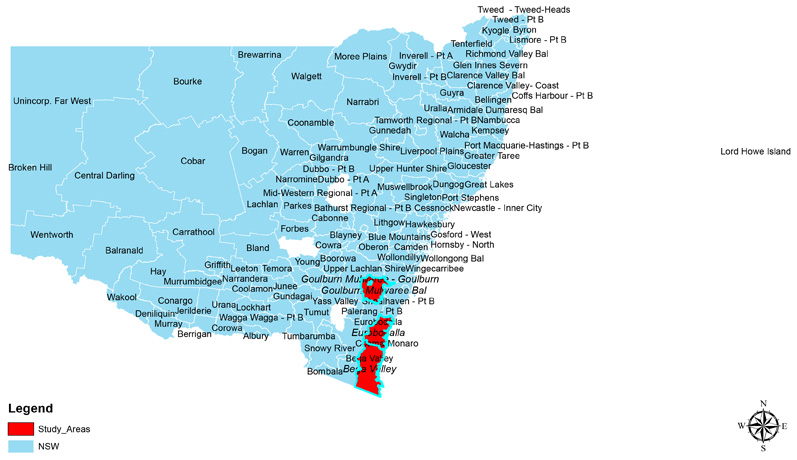
Figure 1: Map showing the study areas in New South Wales of Bega Valley Shire, Eurobodalla Shire and Goulburn Mulwaree.
Results
Demographic information about interviewees
Figure 2 shows the percentage of participants by age. Most participants were aged 55–74, making up 80% of the total sample. There was a drop to 17% of participants who were aged 35–54 and the remaining 3% were aged 18–34. The average age was 60 years.
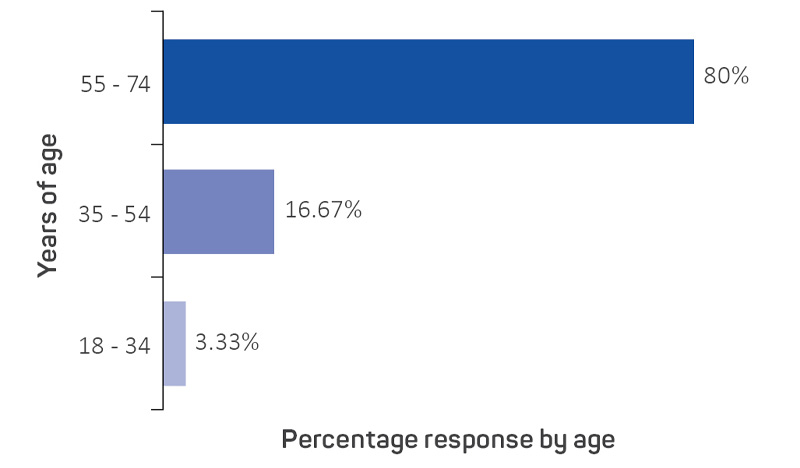
Figure 2: Percentage of participants by years of age.
Participants had been residing in their current location for an average of 13 years. Given this long-term residency, they were considered suitable to provide accounts of their bushfire experiences. Of the sample, 33% had been living in at-risk bushfire areas for over 20 years and 33% had been living in these areas for 5–10 years (Figure 3). A smaller proportion of participants, 13% and 10%, had been living in bushfire at-risk communities for 16–20 years and 5–10 years, respectively (Figure 3).
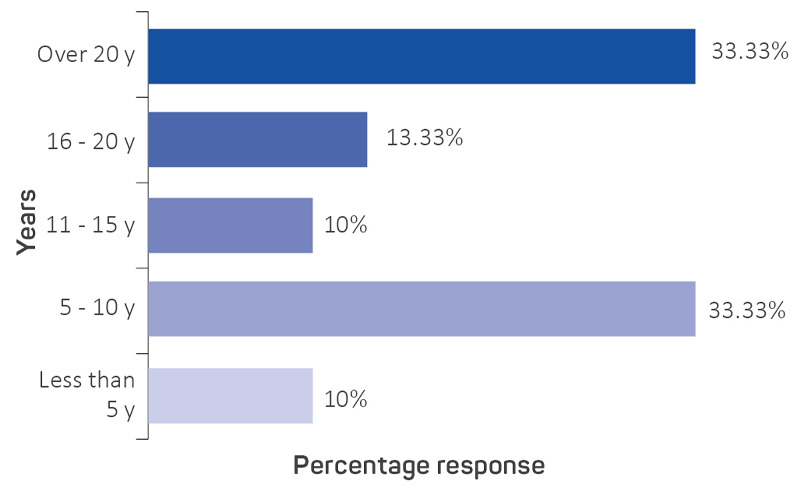
Figure 3: Number of years participants had lived in the location.
Figure 4 shows information about home and contents insurance status of participants. The majority (77%) had full home and contents insurance coverage. However, 17% had no insurance and 7% were underinsured for property and contents. While 93% of participants were homeowners, the remaining 7% were renters or leaseholders (Figure 5).
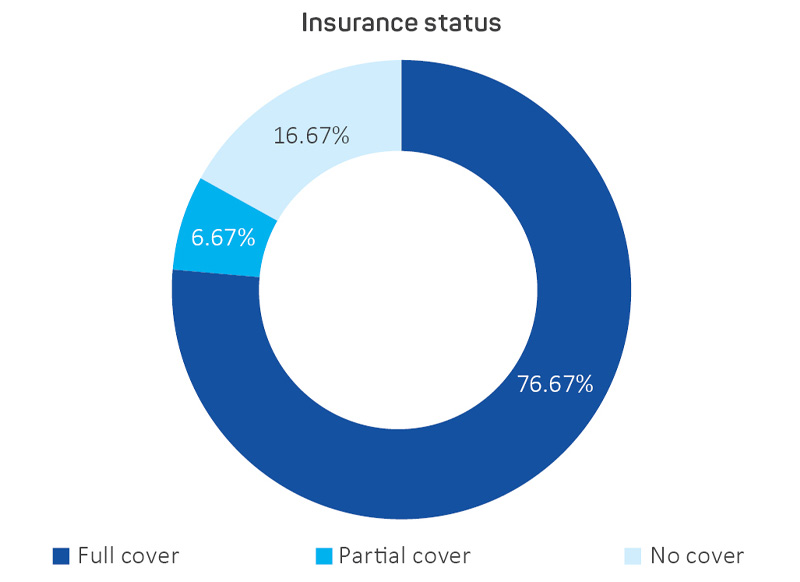
Figure 4: Percentage of properties covered by insurance.
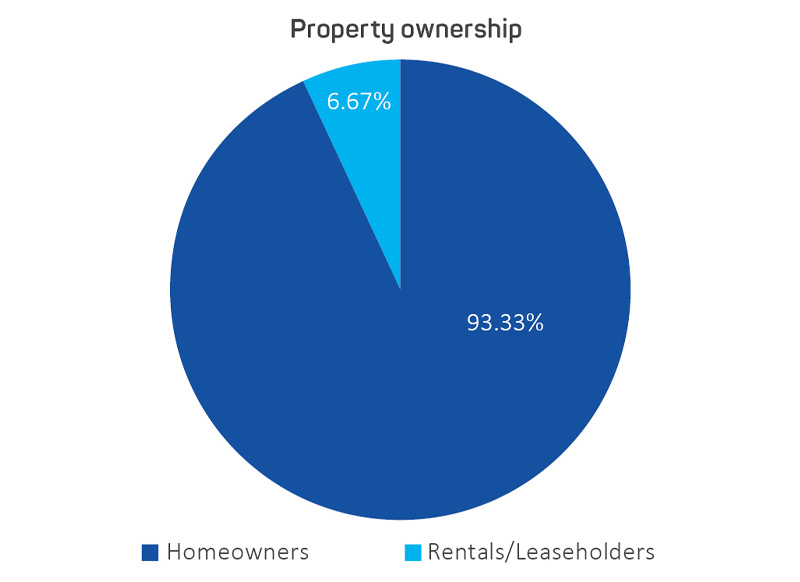
Figure 5: Percentage of participants owning or renting the property.
Figure 6 shows that 80% of the participants had pets or animals and 20% did not. On average, the interviewees lived within 59 metres of bushland (Figure 7).
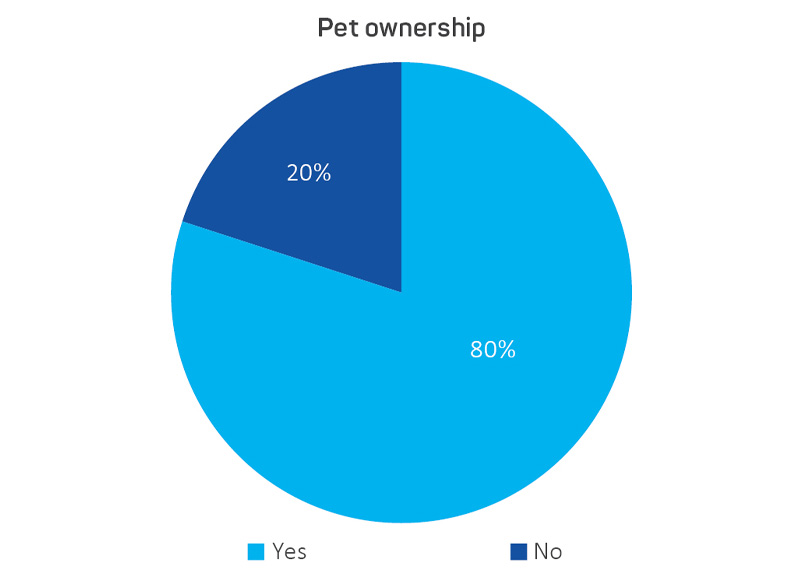
Figure 6: Percentage of participants having a pet.

Figure 3: Percentage of participants and their distance from bushland.
Why householders live in bushfire-prone communities
Generally, participants lived in a wildland urban interface or a bushfire-prone area, an area identified and mapped as red zone under the building system. Participants were asked ‘how did you come to live in this location?’. The responses revealed various factors that had led to their choice of where to live. The reasons included wanting a tree change (moving inland to live in a country area), closeness to family, beauty of the location, having an attachment to that place, convenient for work, property was affordable and relationship related (emotional connection between people). Table 1 lists these factors that are categorised into internal and external factors.
Table 1: Why participants live in bushfire-risk communities.
| Child nodes | Sources | References | Parent node |
| Quest for a tree change | 6 | 10 | Internal factors |
| Proximity to family | 8 | 9 | |
| Location beauty | 6 | 7 | |
| Place attachment | 4 | 4 | |
| Work related | 7 | 7 | External factors |
| Property affordability | 5 | 5 | |
| Relationship related | 2 | 2 |
Quest for a tree change
Most of the participants indicated a desire for a tree change. These participants had moved to the country because they wanted to leave city life and enjoy a comfortable and natural environment. Some of the participants shared their views:
rat race, quite comfortable most of the time at (sic) all right. (MHIE-INTER6_9_14052022)
My wife came from a farm property in the far west and so she wanted to return. I lived in the city, she wanted to return to the country. So, we are doing tree change. (MHIE-INTER1_8_05052022)
The desire of participants for a tree change to a bushfire-prone area reveals a nuanced risk perception. Of these participants who indicated tree change as a reason, males accounted for 55% (n=6) and 45% (n=5) were female. In addition, 72% of these participants had pets they kept on their properties and 18% were without pets. This high percentage pet ownership suggests the role of companionship in fostering resilience (Foenander 2022) and underscores the complexity of decision-making in such conditions.
Proximity to family
Participants indicated that a desire to move closer to their family attracted them to the area. This was evident as proximity to family was mentioned 9 times out of 30. This implies that the presence of relatives and family or the wanting to be with loved ones influences participants to live in the area. Some participants said:
Oh, my family are from this area. They are piney fishermen and farmers from the area for generations. Fishing is fourth generation and the farm is fifth generation. But we did move when I left school. I moved to Canberra and then came back later. I suppose I was about 40. (FHIE-INTER1_16_21062022)
Well, when I retired, I had the choice of where I could live and I found a suitable block of land in the small town I am in… was not too far from relatives. So that is what influenced me in the choice. (FHIE-INTER3_18_22062022)
Some of the participants were deliberate in their choice of living in a bushfire-prone area and were willing to bear some level of risks associated with it. Of these participants, 38% (n=3) were male and 62% (n=5) were female. Also, 75% (n=6) of the participants who indicated proximity to family as a factor also had pets they kept on their properties. This shows the varied motivations that shape the decisions of why people live in bushfire-risk communities.
Beauty of the location
Among the places where people could live, participants preferred bushland areas because these appealed to them based on previous experiences. This suggests that some participants considered the location’s beauty when looking for land to build. The beauty of the location occurred 7 times (23%) out of 30 (see Table 1). Some participants stated:
Well, this valley is a very special place. And I think anyone who visited the valley remembers it. And my partner Peter went there as a child and it stuck in his mind. So, when the opportunity came to get a house there, of course, it seemed like a good thing to do. It is a beautiful, beautiful valley. (FHIE_INTER1_30_02082022)
So yeah, so I think the vulnerability is very high with this place. You know, it is just, I choose to live in a beautiful place and I understand the risks of living here. So I am okay with that. (FHIS-INTER2_6_03052022)
The participants were deliberate about living in a bushfire-prone area and claimed they understood the risks involved. Of these participants who indicated beauty of the location as their reason for living bushland area, 17% (n=1) were male and 83% (n=5) were female, representing a gender disparity in this sample. While 83% (n=5) of participants kept pets on their properties, 17% (n=1) did not have a pet. This, combined with 83% of participants prioritising beauty of location having pets, aligns with Kruize et al. (2019) who examined emotional connections to nature. These choices reflect the complex interplay of aesthetics, risk perception and emotional attachments (Anton and Lawrence 2016).
Place attachment
Table 1 shows that place attachment is a motivator for people to live in bushfire-prone areas. Several reasons responsible for place attachment showed in this study. Some participants had been born in places near bushland and others had holidayed in such locations at a young age. Their experiences contributed to their affection for the regions. Even if they had been away for years, participants indicated that they still identified with it. Some participant responses about place attachment:
So, my mother was born here. And when she was an adult, she moved to Sydney and got married. And so that is where I was born and raised. And then when my parents wanted to retire, they move back to this area. And, like, my grandmother was still alive then. And yeah, so there is lots of family around this area. That is it basically…
(FHIE-INTER3_15_23052022)
So, we came here to Narooma because this is where we had holidayed for a month every single year. Since my husband was a little boy, this is where he came to. So, we came down here, we found a block of land. And we built a house down here. (FHIS-INTER1_9_22062022)
These participants were deliberate about living in a particular place that happens to be bushfire-prone. Of these participants, 44% (n=4) were male and 56% (n=5) were female. Of these, 89% (n=8) had pets on their property and 11% (n=1) did not. This high pet ownership aligns with Foenander (2022) that looked at the role of pets in providing emotional support and resilience in challenging environments. This reinforces the multi-dimensional factors influencing people’s understanding of risk and dealing with the risks associated with their living environments.
Work-related factors
Some participants indicted that the location of their workplace influenced their decision to live in the area (Table 1). Some participants were transferred to the regions, especially government employees like teachers. Others has established businesses in the area. These private business owners were constrained because they thought their business’s potential to thrive was connected to being in such a location. Participants said:
I was transferred here in a teaching position with TAFE a long time ago and met my husband and then I got a transfer to Sydney. So over three years, we gradually got transferred back to the area. (FHIE-INTER1_2_22042022)
When my son was eight weeks old, we moved here for business. And in 2013, my husband died of cancer, and that business closed. And I went on to work in the community and do various things. So, we were in this house, we built this house in 2000. (FHIE-INTER3_17_22062022)
The data showed that work-related factors contributed to participant choice about living in a bushfire-prone area. In addition, the data showed a nearly equal gender distribution of male and female being 45% (n=5) and 55% (n=6), respectively.
Notably, 82% (n=9) of participants with pets indicates the intertwined relationship between occupational choices, personal preferences and the importance of companionship and again shows the varied motivations that shape decisions on where to live.
Property affordability
Many participants indicated they could only afford to buy land in regional areas and this was the only option available to them as low-income earners. They believed land was cheaper to acquire and build on and presented a lower cost of living than most urban centres. The money constraint they had led to their choice for living in bushland areas. Table 1 shows that property affordability was the second highest response in this study. One participant said:
I could afford to buy a house in Cobargo. When in 2000, I was a single parent, and some money that I invested just happened to be a really good investment. So, I had the opportunity to buy a house. And the only place that I could afford to buy a house was in Cobargo.
(FHIE-INTER7_23_28062022)
Despite acknowledging bushfire risk, participants indicted that affordable land was a consideration in their decision. Of these, 60% (n=3) were female and 40% (n=2) were male. This aligns with studies by Anton and Lawrence (2016) that explored economic factors influencing residence choices, particularly among low- and middle-income earners. The high rate of pet ownership (80%, n=4) points to the socio-economic dynamics that shaped their decisions with pets potentially serving as sources of comfort and companionship (Foenander 2022).
Relationship-related factors
Table 1 shows that some people were living in a bushfire-prone area because they were in a relationship with a partner who lived there. This highlights the importance of social networks and relationships in people’s decision-making and relocation choices. This was categorised as an external factor because these participants cannot influence the other party who currently lives in a bushland area. One participant said:
I had met this woman online. I was living in Queanbeyan and I came down here and met her and travelled back and forth for several months, and then I decided I was sick of driving back and forth. So, I rented a place on the main street [of] Cobargo. (MLUE-INTER8_24_28062022)
The data show that some participants resided in bushfire-prone areas due to their relationships. Of these, 100% were male. This emphasises the effect of personal relationships on living choices.
A growing number of people live in (and many are still relocating to) bushfire-prone communities. Despite this trend in New South Wales (Kruize et al. 2019), a study by Maund et al. (2020) showed that 90% of houses in bushland areas were neither designed nor built to withstand bushfire exposure.
This study from the interviews of 30 participants identified 7 reasons why people live and continue to move into bushland areas. These reasons of quest for a tree change, proximity to family, location beauty, place attachment, work-related factors, property affordability and relationship-related factors align with Kruize et al. (2019) that looked at urban expansion, the high cost of housing and the attractiveness of living in a natural environment. This study also considered work-related and relationship-related factors that affected people’s decision-making and grouped these into internal and external factors.
Limitations
There are limitations in this study that affect its findings. The small sample size of 30 participants reduces the applicability of results to a broader population. The 7 identified reasons may not be exhaustive due to the small sample size, the locations of the study areas and the type of hazard event. However, the small sample size allowed for deeper exploration. The variations and perspectives of this cohort show the need for research with diverse sample groups. The study focused on people currently living in bushfire-prone areas in New South Wales who had recent experience of the 2019–20 summer bushfires. Data collection was done before the official start of the following bushfire season to avoid potential traumatisation of participants.
Conclusion
The reasons identified in this study suggest that people’s motivations are varied and dependent on many factors as well as people’s stages of life. The factors provide valuable insights into the motivations behind choice, including personal desires for lifestyle changes, proximity to family, aesthetic appeal, emotional attachment to the area, work-related factors, affordability and relationship-related aspects. Recognising that factors such as affordability and family ties play a role in people’s decisions to live in bushfire-prone areas could guide initiatives to provide affordable housing or incentives for families to relocate to safer regions. Therefore, understanding the diverse factors that influence people’s choices can have broader implications for disaster preparedness while contributing to community resilience. By tailoring initiatives that address specific motivations, communities might better adapt to the dangers posed by bushfires. This could include localised training to maintain firefighting capabilities, enforcing fire-resistant building practices and creating safe evacuation plans.


